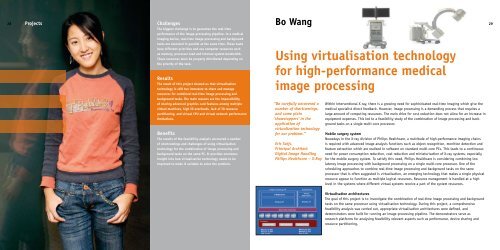20th Anniversary Brochure - Stan Ackermans Institute
20th Anniversary Brochure - Stan Ackermans Institute
20th Anniversary Brochure - Stan Ackermans Institute
Create successful ePaper yourself
Turn your PDF publications into a flip-book with our unique Google optimized e-Paper software.
28<br />
Projects Challenges<br />
29<br />
The biggest challenge is to guarantee the real-time<br />
performance of the image-processing pipeline. In a medical<br />
imaging device, real-time image processing and background<br />
tasks are executed in parallel at the same time. These tasks<br />
have different priorities and use computer resources such<br />
as memory, processor load and internal system bandwidth.<br />
These resources must be properly distributed depending on<br />
the priority of the task.<br />
Results<br />
The result of this project showed us that virtualisation<br />
technology is still too immature to share and manage<br />
resources for combined real-time image processing and<br />
background tasks. The main reasons are the impossibility<br />
of sharing advanced graphics card features among multiple<br />
virtual machines, high IO overheads, lack of IO resource<br />
partitioning, and virtual CPU and virtual network performance<br />
limitations.<br />
Benefits<br />
The results of the feasibility analysis uncovered a number<br />
of shortcomings and challenges of using virtualisation<br />
technology for the combination of image processing and<br />
background tasks on the same PC. It provides enormous<br />
insight into how virtualisation technology needs to be<br />
improved to make it suitable to solve the problem.<br />
Bo Wang<br />
Using virtualisation technology<br />
for high-performance medical<br />
image processing<br />
“Bo carefully uncovered a<br />
number of shortcomings,<br />
and some plain<br />
‘showstoppers’ in the<br />
application of<br />
virtualization technology<br />
for our problem.”<br />
Eric Suijs,<br />
Principal Architect<br />
Digital Image Handling<br />
Philips Healthcare – X-Ray<br />
Within interventional X-ray, there is a growing need for sophisticated real-time imaging which give the<br />
medical specialist direct feedback. However, image processing is a demanding process that requires a<br />
large amount of computing resources. The main drive for cost reduction does not allow for an increase in<br />
equipment expenses. This led to a feasibility study of the combination of image processing and background<br />
tasks on a single multi-core processor.<br />
Mobile surgery system<br />
Nowadays in the X-ray division of Philips Healthcare, a multitude of high-performance imaging chains<br />
is required with advanced image analysis functions such as object recognition, monition detection and<br />
feature extraction which are realised in software on standard multi-core PCs. This leads to a continuous<br />
need for power consumption reduction, cost reduction and miniaturisation of X-ray systems, especially<br />
for the mobile surgery system. To satisfy this need, Philips Healthcare is considering combining low<br />
latency image processing with background processing on a single multi-core processor. One of the<br />
scheduling approaches to combine real-time image processing and background tasks on the same<br />
processor that is often suggested is virtualisation, an emerging technology that makes a single physical<br />
resource appear to function as multiple logical resources. Resource management is handled at a high<br />
level in the systems where different virtual systems receive a part of the system resources.<br />
Virtualisation architectures<br />
The goal of this project is to investigate the combination of real-time image processing and background<br />
tasks on the same processor using virtualisation technology. During this project, a comprehensive<br />
feasibility analysis was carried out, appropriate virtualisation architectures were defined, and<br />
demonstrators were built for running an image-processing pipeline. The demonstrators serve as<br />
research platforms for analysing feasibility relevant aspects such as performance, device sharing and<br />
resource partitioning.



